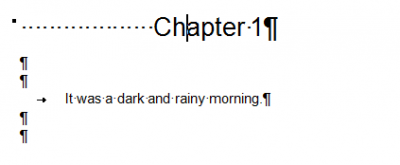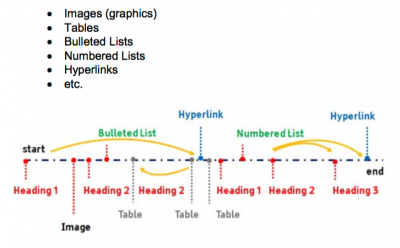This is an old revision of the document!
Table of Contents
Styles & Headings
This section will explain why we use styles, and show you how to apply them to your document.
We consulted with DAISY and our own testing and development in creating these guidelines. This documentation is designed to create the most accessible ebook.
Why styles
We use the Style Pane to format text, and not direct formatting (i.e. we do not use the tools in the toolbar).
Styles allow readers to change how the formatting is presented.
For example, a reader can change the thickness of a bolded word if it has been marked up with the Strong style.
If direct formatting is used, readers can't change the content in a way that works for them (e.g. they are unable to load their own style set).
There are few exceptions to this rule. We use direct formatting for:
- superscript/subscript numbers
- underline and strikethrough (very rarely)
A style is a set of formatting characteristics applied to content.
Always use styles in the Style Pane to control formatting, such as font type, size, bold, italics, etc. In this way, non-visible code gets added to the piece of text that says ‘this is a heading’ (or table, list, image, etc.).
Only use the style pane as directed in this wiki to apply styles to ensure the etext is accessible (unless otherwise instructed).
Styles also give a hierarchical structure to a document’s content. With styles applied, assistive technology can, at the command of the user, jump to the desired part of the document (heading, table, list, images, links, etc.).
By applying this type of formatting, people who have low vision may be able to access and read documents as quickly and as efficiently as those who have good vision.
The image below illustrates how readers using assistive technologies can navigate a document using styles, moving between navigational points, lists, images, and tables.
- TAB characters used to provide indentation
- Multiple Paragraph ‘Return’ characters (¶) used to provide spacing between paragraphs
- Newline breaks (↵)
- Multiple SPACE characters
If any of this exists in the document, then it is not properly formatted with styles. You will need to remove these spaces. See Find & Replace for more instructions.

clear formatting before applying styles. If the issue persists, then simply select the problem text, clear formatting again and reapply the style.
Applying & Changing Styles
Once you have Word set up properly, and all the formatting cleared, you will be able to begin applying styles to the document as per the guidelines in this wiki.
The first step is to clear all formatting in the document:
- Make sure the
Style Paneis open - Select all of the text
COMMAND+Afor MacCTRL+Afor Windows PC
- Select the
clear formattingbutton located at the top of theApply a Stylebox in theStyle Pane
To Apply Styles:
- First select the text you want to apply a style to
- Then select the appropriate style in the
Style Pane - Now that text will be in the selected style
The common styles used are:
- Normal
- Heading (1-6)
- Quote (see Blockquotes & Quotations)
- Caption (see Captions)
- Citation (see Author & Citation Style)
- Emphasis and sometimes Strong (see Bold, Italics, Underline, & Strikethrough)
- Select section you need to fix
- Clear all formatting using the Style Pane
- Reapply the correct style
Show style guides to help keep track of the styles applied in the document. This option is at the bottom of the Style Pane. Once selected it will open a colour coded menu at the left side of the document page. Each colour also has a number, each colour and number correspond to the style you have applied to any given section
Headings
When you create a heading in a document, such as a title or a chapter heading, it is not enough to bold the text or increase the font size. A screenreader cannot “see” the bold letters. Always use the Headings Styles from the Style Pane.
General rules
- As you apply headings to the document, ensure they appear in the navigation pane in the correct order and at the correct level (Heading 2 will be indented relative to Heading 1).
- Nest headings without skipping. For example, if you have a book with two levels of headings, use Heading 1 and Heading 2, not Heading 1 and Heading 3, no matter how small or insignificant the second level of heading might appear. It’s very important to not skip heading levels as the document will not validate as an accessible ebook.
- A heading should not have any line break in between. This will result in two headings of the same level without any text in between. This mark-up is invalid. For example, if the document has the following:
Chapter 1
Basics of Programming
If the same heading style is applied to both the lines above, there will be two headings of the same level since the section name is broken up into two paragraphs. Manually bring the heading name into one line and then apply the heading style. The correct format will be as follows:
Chapter 1 Basics of Programming
Choosing headings
Refer to the table of contents of the book and familiarize yourself with the general layout of the book and the hierarchy of chapters, sections, sub-sections, etc. Determine how you would like to set up the different elements of the book using Heading levels 1-6.
DAISY and EPUB books support heading levels only up to level 6. Most books will have headings only 3 to 4 levels deep. Many books, especially standard fiction works, will only use Heading 1 and no lower levels. This is typical of books that have chapters without sections or subsections.
- Heading 1: Top level sections include sections of front and rear matter, and usually chapters (unless they are arranged in sections or parts).
- Heading 2: Next level breakdown. If a book has 3 Parts each with Chapters, each Part receives a Heading 1 and each Chapter receives a Heading 2.
- Heading 3: Can be used for subsections.
- Heading 4-6: Rarely used.

